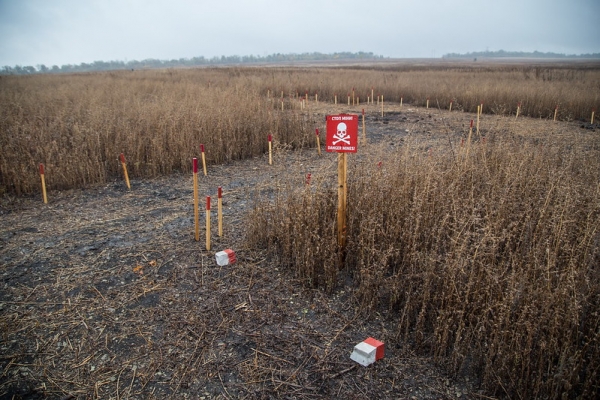On July 26, 2024, Amnesty International, a major non-governmental organisation focused on upholding human rights during peace and war times, published a public statement regarding the use of anti-personnel mines in occupied residential areas in the Russo-Ukrainian War. According to data retrieved from NGOs, the deployment of anti-personnel mines caused the most significant number of civilian casualties compared to those caused by any other type of mine or explosive weapon. In its statement Amnesty Internationalanalyses first the lawfulness of the use of anti-personnel mines under international humanitarian law (IHL) and then its impact on civilians in Ukraine.
Legal standpoint of anti-personnel mines’ use
- Anti-personnel mines treaties
The use, the production and the stockpiling of Anti-personnel mines are prohibited under the 1977 Convention on the Prohibition of the Use, Stockpiling, Production and Transfer of Anti-personnel Mines and on their Destruction, a disarmament treaty also known as the Ottawa Convention. Restrictions on the use of anti-personnel mines, for instance the prohibition on their indiscriminate or direct use against civilians, are also provided in the Protocol II on the Certain Conventional Weapons (CCW) Convention on Prohibition or Restrictions on the Use of Mines, Booby-Traps and Other Devices. With specific regard to Ukraine and Russia, only the former has ratified, acceded and implemented these two treaties regarding the use of anti-personnel mines. However, it must be noted that the fact that Russia is not a party to treaties barring the use of anti-personnel mines does not entail that Russia has no obligations at all when it comes to the use of such weapons.
- The general rule
Although Russia did not ratified the Anti-personnel mines treaties, in deploying anti-personnel mines, it must still abide by IHL principles of distinction, proportionality and precautions in attack, which appear in articles 48, 51, 52 and 57 of the Additional Protocol I to the 1949 Geneva Conventions. Under the principle of distinction, states must distinguish between military objectives and civilians and civilian objects and direct attacks only against the former: direct attacks against civilians and indiscriminate attacks against them are prohibited. Anti-personnel mines are indiscriminate by nature as they would target anyone stepping on them, regardless of whether they are military objectives or civilians. This is also reiterated under customary IHL.
- Deployment of anti-personnel mines as war crime
If anti-personnel mines are used in residential areas to inflict harm to the civilian population intentionally, such use in conflict would constitute a war crime. The very intentional use of anti-personnel mines by Russia would therefore amount not only to a breach of IHL, but also to a war crime, if the intent criteria is satisfied. Because of the very fact that the use of anti-personnel mines by Russians in the Occupied Ukrainian territories may amount to a war crime, there is the need for an independent investigation regarding the use of such weapons to determine whether Russia committed a war crime and determine the perpetrators to deem liable in the affirmative.
Anti-personnel mines’ impact on civilians
Amnesty International has gathered evidence pointing to the use of anti-personnel mines throughout the Ukrainian territories Russia occupied, both in rural and residential areas. The existence of anti-personnel mines on Ukrainian Soil entails risks to civilians, namely physical and mental injury and death. According to the Ukrainian National Mine Action Authority, from the 2022 Russian invasion of Ukraine, there have been at least 76 incidents where civilians have been injured or killed by anti-personnel mines lying in residential areas. Not only, but the risk of injury and death also arises from the fact that, because mine clearance is slow and requires significant capabilities Ukraine does not have by itself but only through funding by other countries, in rural areas where civilians sustain themselves through agriculture are themselves demining their land, risking their lives to achieve food security.
In its analysis of the impact on anti-personnel mines on the civilian population, Amnesty International takes into consideration the specific instances of the cities of Snihurivka, Mykolaivka and Bezimenne, respectively, in the Mykolaiv oblast, the Kharkiv oblast and the Kherson oblast, noting how in Snihurivka, both have used anti-personnel mines. Because of this, in its recommendations, Amnesty International also addresses what Ukraine should do to protect civilians from anti-personnel mines and ensure accountability of those who used them.
Recommendations
In light of the above, noting the effects of the use of anti-personnel mines on the population, Amnesty International:
- Calls on Russia to:
- End the War in Ukraine;
- End attacks on civilians and civilian objects;
- Cease to deploy anti-personnel mines and other indiscriminate weapons, thus to comply with IHL;
- Ratify the Ottawa Convention to achieve a full anti-personnel mine disarmament and to clear those already deployed;
- Immediately take all necessary steps to protect civilians, including demining the areas under its effective control, and hold liable those responsible for war crimes and other international crimes.
- Calls on Ukraine to:
- Report on the investigation into the Ukrainian Armed Forces’ use of anti-personnel mines and publish the findings;
- Comply with the Ottawa Conventions and IHL by refraining from using anti-personnel mines.
- Calls on the international community to:
- Ensure that serious violations of IHL regarding anti-personnel mines in Ukraine are investigated;
- Increase and maintain long-term funding for demining in Ukraine.
- Calls on all states to comply with their duty to ensure respect for IHL under common Art 1 1949 Geneva Conventions and Customary International Law and refraining from transferring mines to either Ukraine or Russia.
To read more, visit:
https://www.amnesty.org/en/documents/eur50/8341/2024/en/
by Ottavia Soldini







